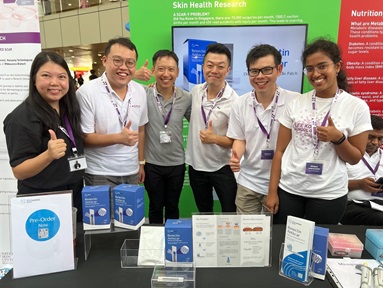Development of new nano-carbon probe as E-tags for cheaper and more accessible polymerase chain reaction test kits
Material also can be used to develop tests for infectious diseases such as COVID-19, human immunodeficiency virus, rabies and tuberculosis.
Optical-based PCR tests are costly to carry out, partly due to the high expenses incurred from fluorescent signalling labels, and the instrumentation required to validate the tests’ results. However, by employing electroactive nanomaterials as signalling labels, PCR results can be validated electrochemically, which offers the possibility for miniaturisation and portable systems for measurements. Also, the electrochemical PCR platform would reduce the cost of PCR tests due to the low-cost carbon nanomaterials. Being cost-effective and portable, the developed electrochemical PCR platform can help low-income rural communities and countries with limited access to PCR tests, as the world continues to grapple with emerging infections that still utilises PCR as the gold standard for detection, like in COVID-19 pandemic.
Our research group aims to utilise nano-carbon materials as innovative E-tags for signal generators in electrochemical PCR. The key ingredient found in our electroactive labels is based on graphene oxide nanocolloids, which are inexpensive and readily available. After activating the carboxyl functional groups on the nano-carbon materials, the latter is used to label specific primers for PCR amplification and also to provide the final quantitative signal. In this work, we have successfully demonstrated the utilisation of carbon nanomaterials as electroactive labels in PCR in having the necessary sensitivity to distinguish between genetically modified and non-genetically modified maize samples.
72ac23ab-25b5-447a-812f-35997f6ff6ea.jpg?sfvrsn=238b19f0_1) Team (Dr Bonanni's Lab)
Team (Dr Bonanni's Lab)
This study is important in determining the effectiveness of the carbon nanomaterials as labels, and can be a crucial stepping stone for the development of a robust, highly sensitive, portable and cost-effective electrochemical PCR system. Besides, its application can be further developed for other infectious diseases like human immunodeficiency virus, rabies, tuberculosis and pertussis (whooping cough). Our research group is now exploring the electrochemical PCR platform for other possible applications in food analysis and clinical investigations. We hope to reach out to industry partners for collaborations.
.jpg?sfvrsn=9777bbd5_1)
Demo Setup Reagents_1 (Dr Bonanni's Lab)
.jpg?sfvrsn=7dfeff08_1)
Demo Setup Reagents_2 (Dr Bonanni's Lab)
[1] Ang, W. L.; Seah, X. Y.; Koh, P. C.; Caroline, C.; Bonanni, A., Electrochemical Polymerase Chain Reaction Using Electroactive Graphene Oxide Nanoparticles as Detection Labels. ACS Appl. Nano Mater. 2020, 3 (6), 5489-5498.
[2] Lim, R. R. X.; Ang, W. L.; Ambrosi, A.; Sofer, Z.; Bonanni, A., Electroactive nanocarbon materials as signaling tags for electrochemical PCR. Talanta 2022, 245, 123479.







